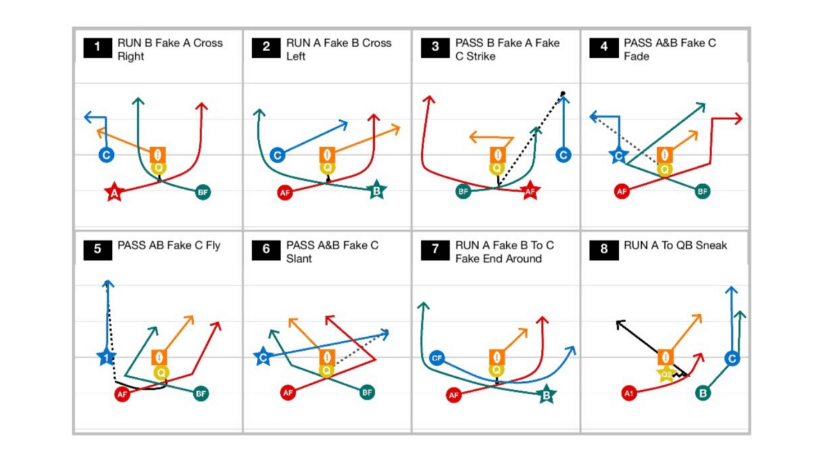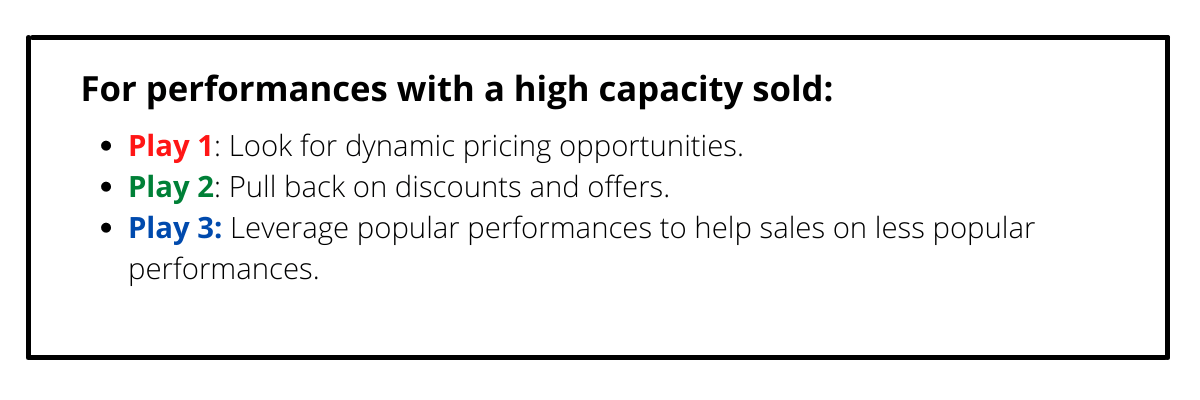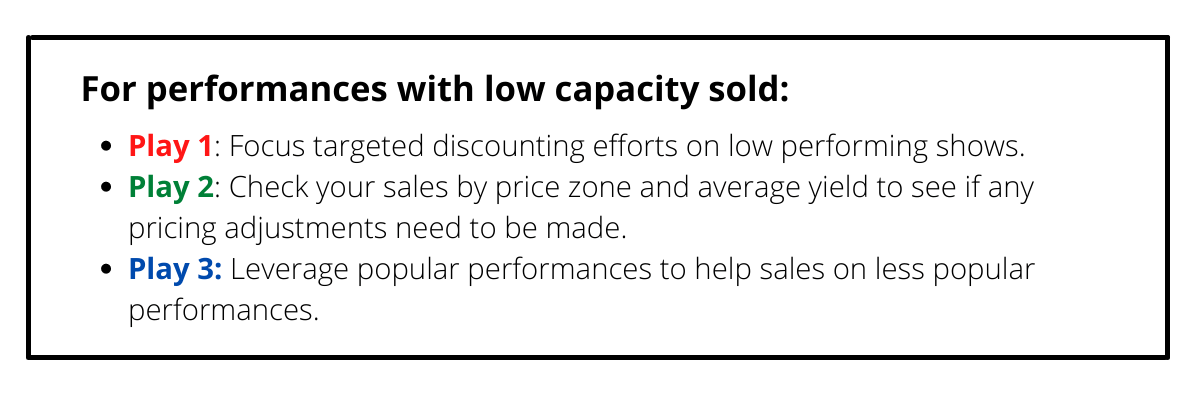The Reopening Playbook: Pricing and Revenue Management

Jennifer Nemeth
Manager, Professional Services
This blog continues our discussion of the Reopening Playbook framework . We designed the playbook framework to help you prepare your strategies for the upcoming season in advance, in order to make in-the-moment decision making easier and more efficient. Our recent post on the Audience Segmentation Playbook reviewed the framework, and how to apply the playbook to your segmentation strategy. In this blog, we’ll focus on the portions of the playbook that involve pricing and revenue management.

The Starting Formation: Starting Prices and Forecasting
The foundation of any playbook is the starting formation. We recently wrote about one aspect of your starting formation: setting audience segments and defining goals. Today, we’re going to focus on where to start with setting prices and forecasting for an unpredictable season.
We at JCA Arts Marketing talk frequently about value-based pricing, which is the idea that an audience member’s willingness to pay for a ticket is directly dependent on the value that that audience member places on the experience. Each audience member values the experience of a performance or exhibition differently, and will be willing to pay different amounts for that experience. This adds a level of complexity to pricing for the arts that doesn’t exist in pricing for basic consumer goods. Adding to that complexity in the current moment is the fact that we don’t yet know how the pandemic will have affected our audiences’ willingness to pay. So, building a playbook will help us nimbly react to changes in audience buying behavior as we encounter those changes throughout the season.
One thing we do know, is that research to this point has not indicated that audiences will be more price sensitive as they return to the arts than they were before the pandemic. So, when you’re setting starting prices for the season, there’s no pandemic-based reason to lower prices right out of the gate (excuse the mixing of sports metaphors).

Aside from starting prices, another important piece of your starting formation is your forecast. It’s typical to forecast upcoming performances based on past performances, and that hasn’t changed coming out of the pandemic. Past sales are still going to be the best predictor for future performance. However, it is possible that changes in audience behavior will affect what sales look like in the upcoming season. Organizations that are used to seeing early sales may see sales shift later, but you still need a baseline forecast so that you can understand what changes are happening, and then react accordingly. And when it comes to reacting—that’s where the plays in your playbook come in!
Building the Playbook: Pricing Plays
Once you’ve set your starting formation including your starting prices and forecasts, the next step is to create your plan for the season. We don’t know exactly how audience behavior will change post-pandemic, so the goal of the playbook is to have strategies ready in order to effectively react to audience behavior. Having plays laid out in advance will help you be efficient and effective in your strategy shifts.
Step 1: Identify Your KPIs & Record Baselines
The first step in creating your pricing playbook is to identify the Key Performance Indicators (KPIs) that will help you recognize when a shift in strategy is necessary. When choosing KPIs, you want to make sure that they are:
- Measurable and trackable—an indicator isn’t going to do you any good if you can’t track it.
- Actionable—you may not want to spend a lot of time and effort tracking something if it’s not ultimately going to impact your strategy and decision making.
Some measures that you might want to track when making your pricing plan include:
- Speed of Sale
- Capacity Sold
- Average Yield
- Cost of Discount
Once you determine your KPIs, the next step is to establish your baseline measures from past seasons. Having a baseline will provide a comparison for 2021-22 audience behaviors, so that you can recognize changes, and react appropriately.
Step 2: Establish Checkpoints
Your carefully chosen KPIs won’t do you any good if you’re not tracking and checking them regularly, so make sure to make a plan for when and how often you’re going to check them and take action. Make sure that it’s frequent enough that you have time to identify when something isn’t working and change it, but not so frequent that you’re tempted to abandon a strategy before it’s had a chance to work.
Step 3: Plan Your Pricing Plays
Once you’ve established your KPIs and checkpoints, you can use your starting prices and forecasts to create a set of plays that you’ll use throughout the season. By thinking through how you might have to adjust your strategies now, you’ll be able to cut down time later when you’re in the thick of the sales cycle.
For example, consider how you might use speed of sale to make changes to your pricing strategies. Speed of sale is a measure that is likely to be different in the coming months compared to pre-pandemic. Your sales cycle may be shorter, audiences aren’t used to planning in advance, and their risk tolerance is likely low–all of which will likely contribute to an increase in late-buying behavior. For that reason, keep in mind that even though the shape of your sales curves might look different from previous years, it will be important not to panic. Having your strategies planned out in advance will keep your decisions strategic and purposeful!

Since sales curves may look different this year, it will be all the more important to pay attention to speed of sales at a micro-level. Track speed of sales for each performance by zone, and look for opportunities to adjust pricing and discounting strategies accordingly. If a single zone is selling faster than those around it, consider raising prices. Or, if a zone is behind, consider focusing your discounts there. By watching speed of sale at an individual performance and zone level, you can make sure to make changes that are strategic and focused, and avoid panic discounting or blanket changes that sacrifice revenue.

Another measure to watch is capacity sold. In particular, keep an eye on relative capacity sold across performances within the season. Comparing sales across the upcoming season, rather than comparing to past seasons, will help you recognize where there is currently demand. Plan now for what you want to do when you see performances with high capacity sold, such as:

And, do the same for performances with low capacity sold. Plan ahead, so that when you have a low-selling performance, it won’t feel like a stressful problem, it will just be an opportunity to use your strategies!

Bringing Your Playbook Together
There are other measures you might choose to track in your organization, but the most important thing is that you identify in advance what you’re tracking and how you’re going to react to the results. By planning your strategies now, you’ll be able to stay calm and collected when making pricing adjustments all season long.
And, don’t forget to review the first half of the playbook which covers segmentation and audience engagement strategies. Together, the full reopening playbook will have you ready to tackle whatever comes your way in 2021-22!
Need Help with Revenue Management?
We’ve got you covered! Our revenue management consultants are here to set your pricing strategies up for success. Whether you’re looking for help with setting prices, dynamic pricing and discounting strategies, subscription structure and pricing, re-zoning your house, or any other aspect of revenue management, we’re here to help.

